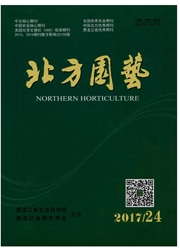

 中文摘要:
中文摘要:
掌握不同生物炭材料的结构特征和化学特性是合理利用生物炭的基础。通过无氧炭化法制备了不同炭化温度下的玉米秸秆生物炭和沙蒿生物炭,对比了不同材料和不同炭化温度下生物炭性质的差异。结果表明:炭化温度低于400~C时,两种材料生物炭的孔隙结构保存完整,600℃以上时,两种材料生物炭的蜂窝状结构均遭到破坏,玉米秸秆生物炭被破坏得更严重;同一炭化温度下,玉米秸秆生物炭的比表面积及总孔容和平均孔径均大于沙蒿生物炭,两种生物炭的比表面积随炭化温度的升高均增大,总孔容呈“V”形变化;两种材料的生物炭均呈碱性,炭化温度越高,pH越大,400℃~800℃,每升高10℃,玉米秸秆生物炭和沙蒿生物炭的pH均以0.02的幅度增加,同一温度下,玉米秸秆生物炭的pH大于沙蒿生物炭,在400~C、600℃和800℃下分别比沙蒿生物炭高0.31、0.35和0.29单位;随炭化温度的升高,玉米秸秆生物炭和沙蒿生物炭的C、P、K和灰分含量增加,400℃~800℃,玉米秸秆生物炭的C、P、K含量以炭化温度每升高10~C分别增加2.94、0.11、0.20g/kg的幅度变化,沙蒿生物炭也以4.35、0.07、0.24g/kg的幅度增加,与此同时,玉米秸秆生物炭的N、H含量以每升高10℃分别以0.13g/kg和0.86g/kg的幅度降低,沙蒿生物炭的N、H含量分别以0.04g/kg和0.82g/kg的幅度下降,s含量无明显变化,C/N和C/H增大,且不同材料生物炭的元素含量差异显著;两种材料生物炭的N、P、K有效性随炭化温度的升高均下降,400℃~600℃,玉米秸秆生物炭和沙蒿生物炭的速效N含量分别下降了57.89%和19.05%,800℃时两种生物炭的速效N均接近0mg/kg,400℃~800℃玉米秸秆生物炭和沙蒿生物炭的速效P含量分别降低了67.41%和52.36%,此时速效K含量也分别降低了45.62?
 英文摘要:
英文摘要:
The structural characteristics and chemical properties of biochars generated from various materials were the basis for the rational utilization of the biochars in agriculture and environment. In this paper, maize straw biochar and Artemisia ordosica biochar were prepared through anaerobic carbonization method at different carbonization temperatures, and their chemical properties were measured. Results showed that the pore structure of the biochars from the two materials was intact below 400℃, while the honeycomb structures of the biochars were destroyed above 600℃. The honeycomb structures of maize straw biochar was destroyed more seriously compared with Artemisia ordosica biochar. The specific surface area, total pore volume and average pore diameter of maize straw biochar were greater than Artemisia ordosica biochar at the same carbonization temperature. The specific surface areas of the two kinds of biochars were increased with the increasing carbonization temperature. The total pore volume of the biochars changed with carbonization temperature as "V" type. The biochars are alkaline, and the higher carbonization temperature led to greater biochar pH. The pH of the biochars was increased by 0.02 units/10℃ in the range from 400℃- 800℃. The pH of maize straw biochar was higher than the Artemisia ordosica biochar at the same temperature, and at 400℃, 600℃ and 800℃ , the pH of maize straw biochar higher than the Artemisia ordosica biochar by 0.31,0.35 and 0.29, respectively. C, P, K and ash contents of the biochars increased with the increasing carbonization temperature. The rise of each 10~C led to the increase in the contents of C, P, and K of maize straw biochar by 2.94 g/kg, 0.11 g/kg, 0.20 g/kg, respectively, and the corresponding data were 4.35 g/kg, 0.07 g/kg, and 0.24 g/kg for Artemisia ordosica biochar. However, the rise of each 10℃ led to the decrease in contents of N and H by 0.13 g/kg and 0.86 g/kg for maize straw biochar, and 0.04 g/kg and 0.82 g/kg for Artemisia ordosica biochar.
 同期刊论文项目
同期刊论文项目
 同项目期刊论文
同项目期刊论文
 期刊信息
期刊信息
